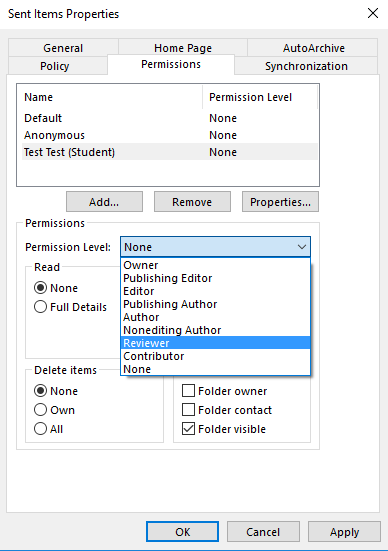Share a Mailbox Folder
You can share any folder in a mailbox, however once shared, some folders are easier to access than others. It is your responsibility to govern the permissions on your mailbox and who is allowed to view the contents. Ensure that you regularly check the permissions on your folders to determine whether you need to perform any housekeeping. If you are responsible for any role accounts, you are also required to keep those permissions up to date.
Sharing a calendar is much easier with recent versions of Microsoft Office and is detailed at the support page: Share an Outlook calendar with other people
The instructions below, although they can still be applied to calendars, are more suited to other Outlook folders.
By default, Outlook folders can have two preset permissions that should not be altered or removed.
| User | Permission |
| Default | None |
| Anonymous | None |
Default is the behaviour for everyone in the University. Avoid changing the permission on Default and Anonymous groups.
Default Outlook Folders:
If you are sharing a 'default' Outlook folder, such as:
- Calendar
- Contacts
- Inbox
- Notes
- Tasks
Right Click on the folder that you want to share, select Properties - Permissions
Click the Add button and find the person that you want to share with. Double Click their name or select the Add button.
Make sure you select the correct person and then use the Permission Level drop-down box to give the appropriate level:
The Permission Level drop-down box contains a number of pre-defined roles that alter the permission check-boxes below. You can create custom permissions by altering these check boxes.
The pre-defined roles include:
Editor
The Editor role allows the user to Create Items, Read Items and makes the folder visible. It also allows them to Edit and Delete all items.
Publishing Author
The Publishing Author role allows the user to Create Items, Read Items, Create subfolders and makes the folder visible. It also allows them to Edit and Delete their own items.
Author
The Author role allows the user to Create Items, Read Items and makes the folder visible. It also allows them to Edit and Delete their own items.
Nonediting Author
The Nonediting author role allows the same permissions as the author only they cannot edit any item. They can delete their own items.
Reviewer
The reviewer role only allows Read Items and Folder Visible Permissions
Contributor
The contributor role only allows the creation of new items.
You will be able to assign permissions to the folder and the person you have shared with should now be able to open the folder.
Note: Calendars also include specific permissions with regard to viewing availability. Information on calendar permissions can be found here
Opening a default Outlook folder:
File - Open - Other User's Folder
Sharing any other folders:
It can be quite complicated to share non-default Outlook folders:
If you want to share any other folder (non-default Outlook folder), you need to assign permissions to the folder that you want to share, but also give Folder Visible permission to any folder above it in the tree and the top level of the mailbox. The top level of your mailbox will usually be your name or email address. You do this in exactly the same manner.
It is important to note that in most instances you will only want to give the Folder Visible permission to your top-level mailbox. This will allow the user to gain access to the folders below this level, but only if you assign permissions to them as well. It does not mean that they have access to all your folders.
Right Click on the folder and select Properties - Permissions. As above Add the user that you want to share with and apply the appropriate permission.
Example:
Say you want to allow someone to read items in a folder called 'Team' that is located as a sub-folder of your Inbox, but you don't want those that you are sharing with to see anything else in the inbox (or indeed the mailbox)
- Test.user@newcastle.ac.uk - Folder Visible (this is the top level of the mailbox. All Outlook folders appear below this).
- Inbox - Folder Visible(as the Team folder is located inside the inbox, you also need to assign folder visible permissions to this folder).
- Team - Reviewer (The actual folder that you want to share).
- Inbox - Folder Visible(as the Team folder is located inside the inbox, you also need to assign folder visible permissions to this folder).
Once all permissions have been assigned, the other person will be able to get access to the folder.
Opening a non-default Outlook Folder
Outlook 2013
Select File - Account Settings - Account Settings
Click Change
Click More Settings
Click Advanced
Click Add
In the Add Mailbox window, enter the user ID of the person that has given you permission to view the folder.
Click OK - OK - Next - Finish
The folder should appear in a separate tree in your Outlook folder list. You should then be able to click down through the folders to reach the shared folder.
Permission housekeeping
It is important to maintain the permissions on your calendar (or any other shared folder) regularly. Remove any users that no longer require access and review permission levels for others.
If you see any user listed similar to: NT USERS: S-1-5-21-985983575-610843327-1947099999-1133, then that is because the user has left the University and their account has been deleted. Remove these users
Permission propagation
Permissions only propagate to sub-folders if the permission is already present on the parent folder before the sub-folder is created.
- If creating a new sub-folder, the permissions will inherit from the parent.
- If the sub-folder already exists, you will need to assign permissions at both levels.

